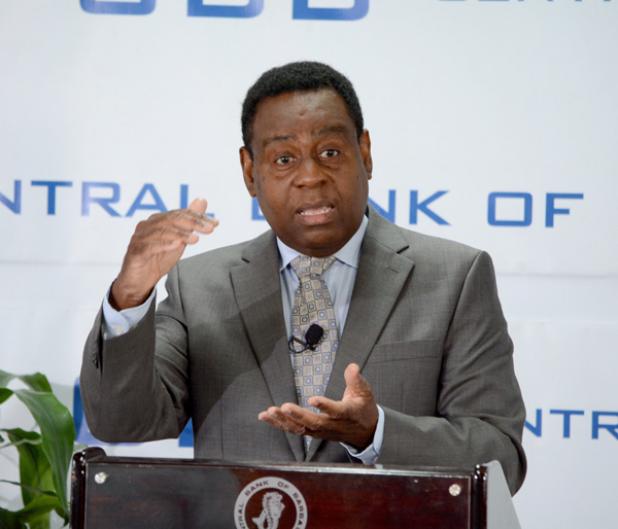
Governor of the Central Bank of Barbados, Cleviston Haynes, in a press conference at the Bank yesterday to give a review of Barbados’ economic performance for 2019.
Growth expected
IF all goes well, the Barbados economy should expand between 1.25 and 1.75 per cent this year.
Governor of the Central Bank of Barbados, Cleviston Haynes, in a press conference at the Bank yesterday to give a review of Barbados’ economic performance for 2019 and the outlook for this calendar year, indicated that this expected growth, if realised, will be made possible by continued growth in tourism and the recovery of private investment.
His comments came as he suggested that special events, including the year-long We Gatherin’ and the 15th UNCTAD quadrennial conference to be hosted here in October, should help to boost the tourism and ancillary sectors as well as complement the activity related to the investment projects that are expected to start throughout the year.
“The overall pace of activity will be influenced by the start-up date of these projects. Investors are finalising plans in several cases and obtaining the necessary regulatory approvals. Implementation of several of these projects is multi-year in scope and this should enhance medium-term growth prospects by enhancing Barbados’ competitive capacity,” he stated.
With that in mind, he said timing will be critical in our ability to achieve the growth, and it is imperative then that all that needs to be done to garner regulatory approval is done.
“The sooner that happens, the faster the growth rate will be. I can’t say to you that standing where I am today, that project X was going to start tomorrow, and therefore I have to hedge my bets. Maybe I have not hedged mine as much as the IMF has hedged theirs, but that really is the essence of the problem. When we meet with the IMF, I don’t think we have large difference in how we see the future evolving, but we have to get the projects started and that really is going to be a critical thing,” he said.
The Governor added that their predictions are also that domestic inflation will slow to within 2.5 per cent to 3 per cent this year. While that is the case, Haynes said there is a “downside risk” to that outlook, related to the agriculture production outturn. Earlier, he noted that in 2019, despite falling international energy and stable imported food prices, inflation took an upward trajectory to 4.1 per cent.
“The relatively benign price environment observed during the first half of the year was disrupted by the impact of persistent drought conditions on non-sugar agriculture, the influx of sargassum seaweed on fish catches and the implementation of policy measures at some state-owned enterprises to increase the level of cost recovery for goods and services offered to the public,” he added.
Reflecting on the previous 12-month period, Haynes indicated that the economy remained “subdued”. He pointed out that real economic activity is estimated to have declined during 2019 by 0.1 per cent. This, he said, is in line with what was expected during the first full year of the adjustment effort.
“However, preliminary data suggests that there were signs of the beginning of a modest recovery during the second half of the year. The tourism sector again registered moderate growth, cushioning the impact of declines in other key areas of economic activity. Commodity exports were relatively flat while weak private sector investment and consumption demand served to constrain overall economic activity,” he said.
Haynes noted that despite the slight decline in the economy, the international reserves rose by $481 million, bringing the figure up to more than 18 weeks of import cover.
He explained that these funds came by way of borrowings from the international financial institutions, the ongoing suspension of commercial external debt payments and a vibrant foreign exchange market, which he explained, allowed commercial banks to sell foreign exchange to the Central Bank.
Additionally, the governor said that public finances improved during the period and with the external debt restructuring that took place, the debt to gross domestic product (GDP) fell further. He went on to say that with the completion of the external debt restructuring, the public sector’s demand for foreign exchange will increase as a result of the resumption of debt service payments. In spite of that, he said further accumulation of international reserves is envisaged, given the prediction of improved economic activity as well as the continuing funding support of international financial institutions. (JRT)
